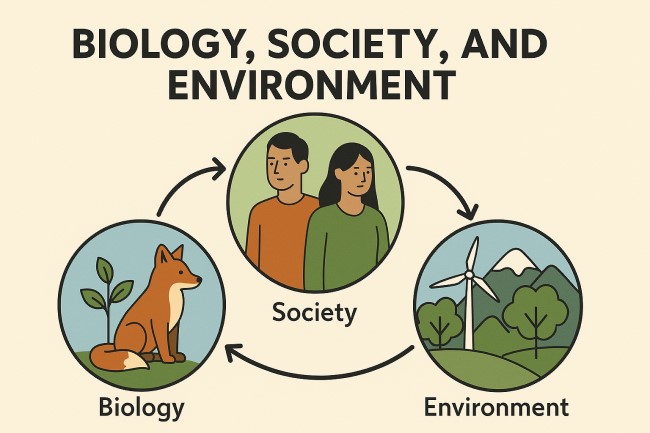Biology Society and Environment: Understanding Their Vital Connection in a Changing World

The study of biology society and environment brings together the science of life, human behavior, and the ecosystems that sustain all living organisms. This interdisciplinary field explores how living systems—humans included—interact with their social and ecological surroundings. With the world facing pressing challenges such as climate change, biodiversity loss, and pandemics, understanding these connections is more essential than ever.
This article explores the relationship between biology, society, and the environment, with a special focus on academic programs like the Biology Society and Environment UMN major. We’ll examine the importance of this field, its real-world applications, and how it prepares future leaders to solve complex global issues.
What Is Biology Society and Environment?
A Holistic Interdisciplinary Field
Biology society and environment is more than a simple mixture of natural science and social science. It is a comprehensive way of understanding the world that acknowledges the tight interdependence of life, human behavior, and nature.
This field combines insights from:
-
Biology – the study of life and living organisms
-
Sociology and anthropology – the study of societies, culture, and behavior
-
Environmental science – the study of ecological systems and human impact
Key Areas of Study
Some common themes covered in this field include:
-
Human impacts on ecosystems
-
Environmental justice and policy
-
Genetics and social behavior
-
Climate change and societal responses
-
Conservation and sustainability ethics
Importance of the Biology-Society-Environment Link
Real-World Relevance
Our health, economy, and survival depend on the balance between humans and nature. Problems like deforestation, pollution, and pandemics demonstrate the cost of ignoring this relationship. Through understanding biology society and environment, students and professionals gain the knowledge to craft solutions that protect both people and the planet.
Case Study: Climate and Health
Consider global warming. The biological effects (species extinction, changes in disease patterns) are inseparable from societal causes (fossil fuel use, urbanization) and environmental outcomes (melting glaciers, extreme weather). Only by addressing all three dimensions—biology, society, and the environment—can we create effective climate policy.
Biology Society and Environment at UMN
What is the Biology Society and Environment UMN Major?
The Biology Society and Environment UMN program at the University of Minnesota offers a unique Bachelor of Arts degree. It’s designed for students who want to understand the biological sciences within a broader human and environmental context.
Program Highlights
-
Integrates biology with social sciences and humanities
-
Offers flexible course choices across disciplines
-
Prepares students for careers in public health, law, education, environmental policy, and more
-
Encourages critical thinking about ethical and social implications of science
Why Choose UMN Biology Society and the Environment?
The UMN biology society and the environment program stands out because of its emphasis on both scientific rigor and social awareness. Students can tailor their curriculum to fit personal goals—whether that’s becoming a doctor, policy advisor, or environmental scientist.
Career Opportunities
Diverse Professional Paths
A background in biology society and environment opens doors in many sectors:
-
Public Health and Epidemiology – understanding how environment affects disease
-
Environmental Policy and Law – shaping regulations to protect people and nature
-
Sustainability Consulting – helping businesses and governments adopt eco-friendly practices
-
Education and Communication – raising awareness through teaching and media
Skills Developed
Graduates develop:
-
Scientific literacy
-
Critical analysis of social systems
-
Policy development insight
-
Ethical decision-making abilities
Addressing Global Challenges
Biodiversity and Conservation
As species disappear at alarming rates, conservation requires knowledge of ecosystems and the people who interact with them. A biology-society-environment approach considers local traditions, economics, and biodiversity all at once.
Pandemic Preparedness
The COVID-19 pandemic reminded the world that biology (viruses), society (behavior, misinformation), and the environment (urbanization, animal trade) are deeply connected. Preventing future crises means understanding how they influence one another.
The Future of Biology Society and Environment
A Path Toward Sustainable Living
Sustainability isn’t just about protecting trees or cutting emissions. It’s about creating systems that are healthy for both humans and the planet. Biology society and environment equips individuals to lead this transformation.
Preparing Change-Makers
From grassroots activists to research scientists, this field prepares leaders to think beyond silos. Graduates of programs like Biology Society and Environment UMN bring interdisciplinary thinking into medicine, education, climate science, and global development.
Conclusion
Biology society and environment is more than just a subject—it’s a lens through which we can view the biggest challenges of our time. By exploring how living organisms, human societies, and natural ecosystems influence one another, this field builds a foundation for informed, ethical, and sustainable action.
Programs like the UMN biology society and the environment major play a critical role in preparing the next generation to connect science with social understanding. Whether you’re interested in public health, environmental justice, or simply making a difference in the world, this dynamic field offers the knowledge and tools you need.



